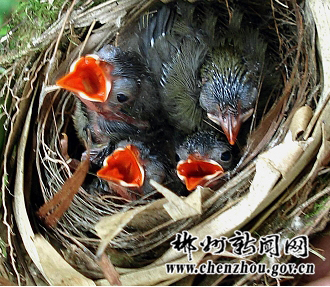Provincial Bird- Red-billed Leiothrix and Their Babies


Red-billed Leiothrix and their babies in Bamianshan Mountain
Red-billed Leiothrix was selected to be Hunan provincial bird on the Fifth China Dongtinghu Lake Bird Festival in December 2007. There are about 3.20 million Red-billed Leiothrix available in Hunan province, which is mainly distributed in Guidong, Liuyang, Yanling and other counties. Among them, 0.5 million are in Guidong county.
The Red-billed Leiothrix, Leiothrix lutea, is a member of the Old World babbler family, and is native to the Indian Subcontinent. Adults have bright red bills and a dull yellow ring around their eyes. Their backs are dull olive green, and they have a bright yellow-orange throat with a yellow chin; females are somewhat duller than males, and juveniles have black bills. It has also been introduced in various parts of the world, with small populations of escapees having existed in Japan since the 1980s. It has become a common cagebird and amongst aviculturists it goes by various names: Pekin Robin, Pekin Nightingale, Japanese Nightingale, and Japanese (Hill) Robin, the last two being misnomers as it is not native to Japan.
The leiothrix is about six inches in length, generally olive green, and has a yellow throat with orange shading on the breast. It also has a dull yellowish ring around the eye that extends to the beak. The edges of the wing feathers are brightly colored with yellow, orange, red and black and the forked tail is olive brown and blackish at the tip. The cheeks and side of the neck are a bluish gray color. The female is a lot paler than the male and lacks the red patch on the wings. It doesn’t fly frequently, except in open habitats. This bird is very active and an excellent singer but very secretive and difficult to see.
This bird feeds on both plant and animal matter. It eats fruits such as strawberries, ripened papaya, guavas and also various species of Diptera, Mollusca, Lepidoptera, and Hymenoptera. Its food is usually gathered from foliage and dead wood and it usually searches for food in lower strata of vegetation.
The leiothrix can usually be found in a group of about ten to thirty birds during the non-breeding season; however, during the breeding season the birds break off into pairs and become territorial. These birds have a song which consists of short powerful notes that are repeated continuously throughout the year but it is more persistent during the breeding season. This period usually lasts from early April until September and they are usually found around well watered areas. The males sing long complex songs with a wide array of syllables to attempt to attract the female.
The leiothrix is an open cup nester. The nests of the Red-billed Leiothrix are composed of dry leaves, moss and lichen; however, they are not well hidden because concealment isn’t really a primary factor when determining a nest site. Several nests are found between April and June and are placed within ten feet of the ground. Dense vegetation provides the shrub nesting species protection against predators.
The eggs of the leiothrix are found in clutches of two to four eggs with an average of three. They are broad and blunt in shape with some gloss on the outside and they also have a pale blue color and red like brown spots that encircle the larger end of the eggs. The newly hatched birds have bright red skin and a rich orange red gape.




